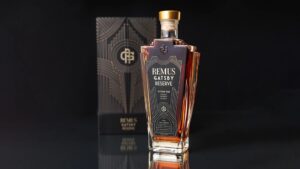By Andrew Graham
Rating: B
 I have become quite a fan of most of what’s in the George Remus portfolio. We’ve talked about Remus here before, but in short, it is one of two in-house brands of MGP, the distillery on the Indiana-Kentucky border that’s more commonly associated with large-scale contract distilling.
I have become quite a fan of most of what’s in the George Remus portfolio. We’ve talked about Remus here before, but in short, it is one of two in-house brands of MGP, the distillery on the Indiana-Kentucky border that’s more commonly associated with large-scale contract distilling.
What’s easy to miss about MGP is that while, yes, it will gladly sell non-distilling producers barrels of juice for them to do with what they please, it also maintains stock of some truly miraculous, well-aged bourbons. The Remus Repeal Reserve VI is one such example, and the Gatsby Reserve is its latest foray into the premium, high-age-statement bourbon category.
To dive into the specs further: this is a 15 year old whiskey bottled at 97.8 proof, labeled as cask strength. This got me thinking about barrel entry proof.
MGP bourbons reportedly have a barrel entry proof of 120, and high humidity tends to lower the proof of whiskey as it ages. So going from 120 proof to a bit under 100 in 15 years makes sense under that logic. But Michter’s, which is said to have a lower entry proof of 103 (and which participates in the premium, high-age-statement bourbon category as well), sells a 20-year bourbon, ostensibly at barrel strength, that’s 114 proof.
So, we have two bourbons with high age statements coming to market now, which were aged in or near Kentucky. One went from 120 proof to around 98 proof, while the other went from 103 proof, assuming the reported entry proofing of Michter’s is accurate, to 114 proof. This might seem paradoxical, but it’s actually part of the complexity of maturing a barrel of whiskey.
The barrel is a breathable vessel, filled with both water and alcohol. Most enthusiasts know that whiskey evaporates from the barrel over time, but the conditions in which the barrel ages determines how much of which part evaporates. Hot, dry conditions will pull more water out of the barrel, leaving the alcohol to concentrate. A warm, damp environment will keep the water in the barrel, but allow the alcohol to depart. Finally, a cool, damp climate reduces evaporation in general. Thus, storing a barrel on the top floor of a tin-sided rickhouse will cook the contents every summer, probably resulting in a Hazmat whiskey; but storing the same barrel in the ground floor of a brick rickhouse should slowly reduce the alcohol content over the summers.
The Bourbon
The Gatsby Reserve hit me with a nose of new wood and creme brulee that was less robust when compared to the two iterations of the Repeal Reserve I’d previously had, IV and VI, which I remember were enormously fragrant.
The flavor profile, however, is quite remarkable and more than makes up for whatever the nose might be lacking, at least, to me. I got strong flavor notes of toffee, milk chocolate, cherry cola, and tobacco, with a touch of pistachio and a faint hint of smoke. I also got a tannic, bitter finish that dried my mouth. The nuttiness and char were unique.
The Price
The Gatsby Reserve has a suggested retail price of $200, but good luck finding it for that. More realistic is finding it on the secondary market, or at retailers that mark up scarce expressions, for twice that or more.
 The Whiskey Reviewer A World of Whiskey, Poured Every Weekday
The Whiskey Reviewer A World of Whiskey, Poured Every Weekday
